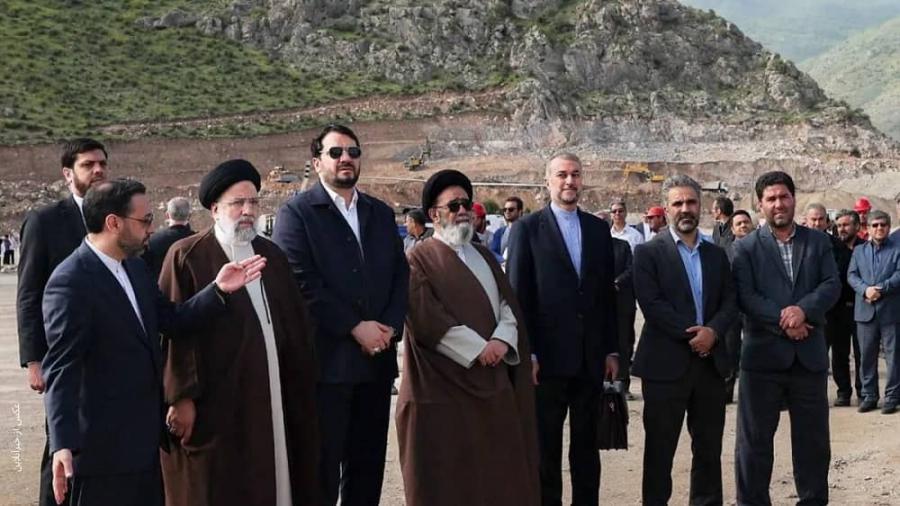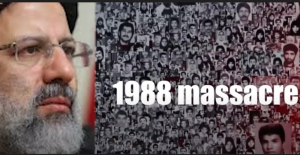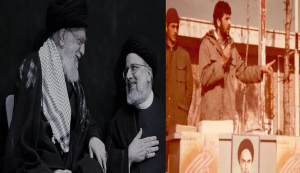
(Video) Iran: Regime’s President Ebrahim Raisi Confirmed Dead in Helicopter Crash
Ebrahim Raisi's background clarifies why Khamenei has chosen him as the head of the Judiciary and possibly the future supreme leader of the regime.
PARIS, FRANCE, May 20, 2024 /EINPresswire.com/ -- The National Council of Resistance of Iran (NCRI) Foreign Affairs Committee in an article reported that following hours of speculation and delay, the Iranian regime’s state television has officially announced the death of Ebrahim Raisi and those accompanying him on a helicopter flight that crashed in East Azerbaijan Province earlier today.
In his first public appearance following Raisi’s helicopter crash, the Iranian regime’s Supreme Leader, Ali Khamenei, sought to prevent a morale breakdown among his forces and urged state officials to ensure that no unrest occurs. State media reported Khamenei speaking at a meeting with a handpicked crowd of IRGC family members, saying: “We hope that God Almighty does not deprive the country of the blessing of the President’s and his companions’ service.
However, the dear people should be assured that officials are working with redoubled effort, and we have given them the necessary recommendations. The Iranian nation should not worry or be anxious; no disruption will occur in the country’s affairs.”
Raisi’s convoy consisted of three helicopters, with Raisi’s helicopter being the only one that failed to reach its destination safely. Among the passengers were the regime’s Foreign Minister Hossein Amir-Abdollahian, Tabriz’s Friday prayer leader Mohammad-Ali Alehashem, East Azerbaijan Governor Malek Rahmati, and several other officials.
For several hours, state-run news agencies reported the helicopter carrying Raisi had crashed, but attempts to contact the passengers were unsuccessful, with all phone lines going unanswered.
Rescue teams were dispatched to the crash site, but their efforts were hampered by adverse weather conditions.
Interior Minister Ahmad Vahidi confirmed the crash, stating, “Rescue teams have not yet reached the accident site. We have no communication or information.” He explained that the helicopter was forced to make a “hard landing” due to adverse weather conditions on the return journey from the inauguration of the Qiz Qalasi Dam with the President of Azerbaijan.
As news of the crash unfolded, the Islamic Revolutionary Guard Corps (IRGC) changed its telegram channel avatar’s color to black, while state officials urged Iranians to pray for Raisi’s survival. However, the regime’s hopes were shattered when state television officially declared Raisi and his companions dead.
Ebrahim Raisi has a chilling record of human rights abuses and crimes against humanity. Skipping education and ambitiously joining the IRGC and later the brutal Judiciary as a prosecutor, he was one of four members of the notorious “Death Commission” that oversaw the extrajudicial executions of thousands of political prisoners, primarily supporters of the Mujahedin-e-Khalq (MEK/PMOI), in a mass killing spree that came to be known as the 1988 massacre.
Decades later, as Iran’s Chief Justice from 2017 to 2021, Raisi presided over a brutal crackdown on nationwide protests in 2019, granting blanket impunity to security forces responsible for unlawfully killing hundreds of men, women, and children, and subjecting thousands more to mass arrests, enforced disappearances, torture, and other ill-treatment.
Who is Ebrahim Raisi, and what is his background?
On June 19, 2021, in a sham election, Ebrahim Raisi was selected as the eighth President of the Iranian regime. The promotion of Raisi as President by the regime’s supreme leader met widespread international outrage.
On the same day, Amnesty International announced that Raisi must be investigated for crimes under international law instead of assuming power. In a report issued in 2018, Amnesty International identified Ebrahim Raisi as a member of the “death commission,” which carried out executions of several thousand members of the Mujahedin-e Khalq (MEK) and other political groups in prisons throughout the country between late July and early September 1988.
International Federation for Human Rights reported that Raisi played an important role in the repression and execution of protestors after the controversial 2009 presidential election in Iran.
Human Rights Watch reported: “During his judicial career, Raisi oversaw some of the most heinous crimes in Iran’s recent history, which deserve investigation and accountability rather than an election to high office.”
Ebrahim Raisi, known as “Butcher of Tehran” for his role in the 1988 massacre of over 30,000 political prisoners in Iran, has played a key role in the execution of thousands of political prisoners in Iran.
On June 2, 2020, Raisi defended the mullahs’ crimes against humanity and, while referring to Khomeini, the regime’s founder, said:
“At a meeting that I attended with three or four of our colleagues with [Khomeini]. There was a report regarding a number of these cases. When we were leaving, we were all thinking that [Khomeini] was more revolutionary than us.
We had gone there to say we are doing this and that… thinking [Khomeini] may say we are going too far. We saw that [Khomeini] is many steps ahead of us. Not only did he encourage us, he also said we should pursue these measures with a far more serious drive, and not just in Tehran, but in all other provinces,” Raisi continued.
In 1988, Grand Ayatollah Hossein-Ali Montazeri, Khomeini’s successor at the time and a higher-ranking cleric than current Supreme Leader Ali Khamenei, and his minions summoned members of the Death Committee, including Raisi. Montazeri addressed them in a recorded and later published meeting, stating, “The greatest crime committed under the Islamic Republic, for which history will condemn us, has been committed by you. Your (names) will in the future be etched in the annals of history as criminals.”
A glance at Ebrahim Raisi’s background clarifies who he is and why Khamenei has chosen him as the head of the Judiciary and possibly the future supreme leader of the regime.
Background:
Mullah “Ebrahim Rais-al-Sadati,” known as Ebrahim Raisi, was born in 1959 in the Noghan neighborhood in the city of Mashhad, Khorasan Razavi province. After finishing elementary school, he studied in Mashhad’s seminary. His non-seminary education is only up to sixth grade. He was sent from Mashhad’s seminary to Qom’s seminary at the age of 15.
Raisi was eighteen at the time of the 1979 anti-monarchic revolution. In the first days of the establishment of the regime, at the invitation of Hadi Marvi, Ruhollah Khomeini’s representative in Masjed-e-Soleiman, Raisi went to Masjed-e-Soleiman, and his connection with the clerical court began.
A year later, after returning from the crackdown on Masjed Soleiman, Raisi was sent to the Karaj Prosecutor’s Office as a judge while he was just 19 years old. His job there was basically to interrogate detainees.
At the age of 20, the then Revolutionary Prosecutor, the criminal cleric Ali Qoddusi, appointed Ebrahim Raisi as the Karaj Prosecutor. After a few months and after countless crimes in Karaj, Ebrahim Raisi was appointed as the Prosecutor of Hamedan while simultaneously retaining his position in Karaj.
Raisi continued to suppress the people until 1984 as the Prosecutor of Hamedan. In 1984, when mullah Ali Razini became the head of the Central Revolutionary Prosecutor’s Office, he appointed Ebrahim Raisi as the deputy head of the Central Revolutionary Prosecutor’s Office.
At the time, the Central Prosecutor’s Office had three deputies: an economic deputy, a drug trafficking deputy, and a so-called “grouplets” deputy. Raisi, then 24, became deputy for grouplets. Raisi, then deputy of the Revolutionary Court Prosecutor’s Office, actively participated in all the regime’s atrocities. Particularly, he played an active role as a member of the Tehran “Death Commission” during the 1988 massacre.
The 1988 Massacre Death Commission
In the summer of 1998, following a fatwa by Khomeini, over 30,000 political prisoners, mostly members and supporters of the People’s Mojahedin Organization of Iran (PMOI/MEK), were executed in various Iranian prisons, including Evin Prison in Tehran and Gohardasht Prison in Karaj.
Raisi, who was Tehran’s Deputy Prosecutor at the time, along with mullah Hossein Ali Nayyeri, the Sharia judge; Morteza Eshraqi, Tehran Prosecutor; mullah Mostafa Pourmohammadi, Deputy Minister of Intelligence; and Ismail Shushtari, head of the prisons department, were members of the Central Committee of the “Death Commissions,” which oversaw the 1988 massacre. This committee was commissioned by Khomeini to massacre and execute all political prisoners who remained steadfast in their positions.
On August 9, 2016, Ahmad Montazeri, the eldest son of Ayatollah Montazeri, who was Khomeini’s successor until the 1988 massacre, made public the tape of the August 15, 1988 meeting of his father with members of the Tehran “Death Commission.” During the meeting, Ayatollah Montazeri strongly criticized the executions and said to the Death Commission: “History will condemn us and will register your name as ‘criminals.'”
In his memoirs, Montazeri states: “It was first of [Islamic holy month of] Muharram; I asked Mr. Nayyeri, Mr. Eshraqi, Mr. Raisi, and Mr. Pourmohammadi and said, ‘Now is Muharram. At least stop the executions in Muharram.’” Montazeri continues: “Mr. Nayyeri told me: ‘We have so far executed 750 in Tehran and separated 200 as those persevering on their position. Let us finish them, and then whatever you say, we shall do it.’”
Thus, Ebrahim Raisi, who had been part of the Khomeini regime’s killing machine since he was 18, played one of the main roles in the bloodbath of religious fascism at the age of 28 as a member of the 1988 Death Commission. Some of the survivors of the executions have narrated that they saw Ebrahim Raisi in the corridors and torture chambers of the prison while he was working on the execution cases without religious clothes or a turban and wearing comfortable clothes.
Ebrahim Raisi, who proved his ruthlessness during the 1988 massacre and gained Khomeini’s special trust after this massacre, was greatly appreciated by Khomeini and received orders to hold top positions.
Continued killings and crimes after the 1988 massacre
On January 1, 1989, after being convinced of Raisi’s brutality as Deputy Prosecutor of Tehran, Khomeini selected him to be in a two-member delegation alongside the Nayyeri. The two were tasked with issuing death sentences and ordering amputation of limbs to increase repression “regardless of the administrative difficulties.”
Khomeini’s order:
His Excellency, Hojjat al-Eslam Mr. Nayyeri,
Since I have received numerous reports of the weakness of the judiciary, and the honorable and committed people of Iran expect a more serious approach to various issues, Your Excellency and Hojatoleslam Raisi will be given a judicial mission to investigate the reports from the cities of Semnan, Sirjan, Islamabad and Doroud, and to carry out what is God’s command in these cases, regardless of the administrative difficulties. May peace be with you.
January 1, 1981, Ruhollah Khomeini
Abdul-Karim Mousavi Ardebili, then head of the regime’s Supreme Judicial Council, saw his position in danger following Khomeini’s letter to Raisi and Nayyeri. Therefore, he abruptly rushed to Tehran’s Friday Prayers on January 20, 1989, and said:
“The shackling problems of the judicial system prevented the issuance of sentences, and Imam Khomeini was recently informed that the issuance of sentences would be delayed due to cumbersome problems.
He paid close attention and sent a letter emphasizing that the execution of God’s commands should not be delayed. When Imam said this, and we felt that we had this permission from the Imam; within 24 hours: four people were executed, two hands were cut off, and three people were imprisoned.
The Tracking Office is available day and night and can be notified by phone. Just tell us such a thing has happened, and we will end the matter in 3, 4, or 5 days by using the order of the Imam, by creating extraordinary ad-hoc courts.”
A day after Mousavi Ardebili’s speech declaring his position, Khomeini issued a new order increasing Raisi’s authorities and instructing the regime’s Supreme Judicial Council to give Raisi and Nayyeri all the stagnant cases to see to the death sentences, floggings, and amputations so that the accused could be punished as soon as possible.
Khomeini’s second order:
“Supreme Judicial Council of the Islamic Republic,
Give all the cases, surprisingly left stagnant at the council, and those that have delayed the execution of God’s order, to Hojatoleslams Raisi and Nayyeri, so they could execute God’s orders as soon as possible, as delays are not permissible.
Ruhollah Khomeini – January 21, 1989.”
Raisi didn’t simply gain Khomeini’s trust and Khamenei’s special attention. His judicial positions, as someone deeply involved in crimes respectively are:
Investigator in Masjed Soleiman Prosecutor’s Office, Prosecutor in Karaj Prosecutor’s Office, Karaj Prosecutor, Hamadan Prosecutor, Deputy Prosecutor General of the Tehran Revolutionary Court; and after the 1988 massacre, Revolutionary Prosecutor of Tehran, head of the General Inspectorate, First Deputy Chief of the Judiciary, Special Prosecutor of the Court of the Clergy, Chairman of the National Television Supervisory Council, and Attorney General. He has been involved in all of the regime’s crimes throughout these years.
In a speech at the opening of the 23rd National Assembly of Revolutionary Guards (IRGC) Commanders and Officials on September 30, 2019, Raisi described his cruelty during these years by saying: “We will not cut the fingers of those who are corrupt; we will cut off their entire hand.” Even the state-run news agencies were not able to exactly quote this sentence and tried to change it in many forms.
To view the whole text, please use the link below.
https://www.ncr-iran.org/en/publications/special-reports/iran-who-is-ebrahim-raisi/
If you wish to receive the NCRI weekly Newsletter, please use the following link to subscribe: https://bit.ly/3SMgEla.
Shahin Gobadi
NCRI
+33 6 61 65 32 31
email us here
News agencies reported the helicopter carrying Raisi had crashed, but attempts to contact the passengers were unsuccessful, with all phone lines unanswered.
EIN Presswire does not exercise editorial control over third-party content provided, uploaded, published, or distributed by users of EIN Presswire. We are a distributor, not a publisher, of 3rd party content. Such content may contain the views, opinions, statements, offers, and other material of the respective users, suppliers, participants, or authors.






